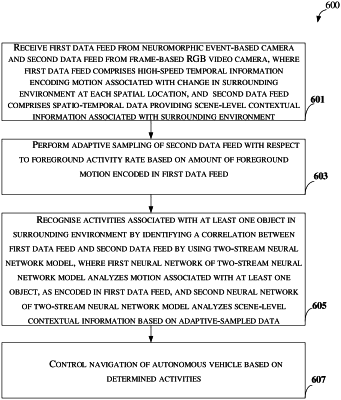| CPC B60W 60/001 (2020.02) [G06N 3/045 (2023.01); G06T 7/246 (2017.01); G06V 20/40 (2022.01); G06V 20/56 (2022.01); G06T 2207/20084 (2013.01); G06T 2207/30252 (2013.01)] | 15 Claims |

|
1. A method of recognising activities in surrounding environment for controlling navigation of an autonomous vehicle, the method comprising:
receiving, by an activity recognition system of the autonomous vehicle, a first data feed from a neuromorphic event-based camera and a second data feed from a frame-based RGB video camera, configured in the autonomous vehicle, wherein the first data feed comprises high-speed temporal information encoding motion associated with a change in the surrounding environment at each spatial location, and the second data feed comprises spatio-temporal data providing scene-level contextual information associated with the surrounding environment;
performing, by the activity recognition system, adaptive sampling of the second data feed with respect to a foreground activity rate based on an amount of foreground motion encoded in the first data feed;
recognizing, by the activity recognition system, activities associated with at least one object in the surrounding environment by identifying a correlation between the first data feed and the second data feed by using a two-stream neural network model, wherein a first neural network of the two-stream neural network model analyzes motion associated with the at least one object, as encoded in the first data feed, and a second neural network of the two-stream neural network model analyzes the scene-level contextual information based on the adaptive-sampled data; and
controlling, by the activity recognition system, the navigation of the autonomous vehicle based on the determined activities.
|